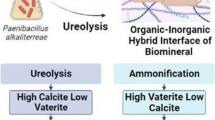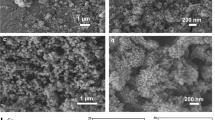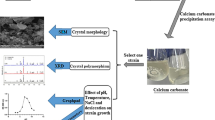Abstract
The present research aimed at evaluating the effects of urease enzyme and increasing pH on calcite nanocrystal formation. Unlike some researches, the results showed that CaCO3 precipitation is not a general phenomenon among the bacteria and if a bacterium has not this ability, it will not be able to produce calcite even with an increase in pH. All urease-positive bacteria had this ability, while only some urease-negative bacteria were able to produce calcite. Production and characterization of nanocrystals on precipitating medium were shown primarily by light microscopy and then confirmed by X-ray diffraction (XRD) analysis. Crystallite particle size was determined using Scherrer formula that was sub-100-nm in all samples. Based on qualitative and quantitative studies, strain C8 was selected as the best calcite-producing strain. Phylogenetic analysis indicated that this isolate has 99 % similarity with Enterobacter ludwigii. 16S rRNA sequence of isolate was deposited in GenBank with accession number JX666242. The morphology and exact composition of nanocrystalline particles were determined using scanning electron microscopy (SEM) and energy-dispersive X-ray spectroscopy (EDX). According to data obtained by SEM, we suggest that nanocrystals of CaCO3 adhere to bacteria and each other to form small aggregates and then complex crystalline networks to trap bacteria. Many holes are present in these crystalline networks that seem to be due to the aggregation of nanocrystals.




Similar content being viewed by others
References
Aloisi G, Gloter A, Kruger M, Wallmann K, Guyot F, Zuddas P (2006) Nucleation of calcium carbonate on bacterial nanoglobules. Geology 34:1017–1102
Al-Thawadi SM (2011) Ureolytic bacteria and calcium carbonate formation as a mechanism of strength enhancement of sand. J Adv Sci Eng Res 1:98–114
Arp G, Hofmann J, Reitner J (1998) Microbial fabric formation in spring mounds (‘microbialites’) of alkaline salt lakes in the Badain Jaran Sand Sea, PR China. Palaios 13:581–592
Banks ED, Taylor NM, Gulley J, Lubbers BR, Giarrizzo JG, Bullen HA, Hoehler TM, Barton HA (2010) Bacterial calcium carbonate precipitation in cave environments: a function of calcium homeostasis. Geomicrobiol J 27:444–454
Barabesi C, Galizzi A, Mastromei G, Rossi M, Tamburini E, Perito B (2007) Bacillus subtilis gene cluster involved in calcium carbonate biomineralization. J Bacteriol 189:228–235
Barton HA, Spear JR, Pace NR (2001) Microbial life in the underworld: biogenicity in secondary mineral formations. Geomicrobiol J 18:359–368
Bissett A, de Beer D, Schoon R, Shiraishi F, Reimer A, Arp G (2008) Microbial mediation of stromatolite formation in karst-water creeks. Limnol Oceanogr 53:1159–1168
Braissant O, Decho AW, Przekop KM, Gallagher KL, Glunk C, Dupraz C, Visscher PT (2009) Characteristics and turnover of exopolymeric substances in a hypersaline microbial mat. FEMS Microbiol Ecol 67:293–307
Cacchio P, Ercole C, Cappuccio G, Lepidi A (2003) Calcium carbonate precipitation by bacterial strains isolated from a limestone cave and from a loamy soil. Geomicrobiol J 20:85–98
Castanier S, Le Metayer-Levrel G, Perthuisot JP (1999) Ca-carbonates precipitation and limestone genesis: the microbiologist point of view. Sediment Geol 126:9–23
Chahal N, Rajor A, Siddique R (2011) Calcium carbonate precipitation by different bacterial strains. Afr J Biotechnol 10:8359–8372
Chen L, Shen YH, Xie AJ, Huang B, Jia R, Guo RY, Tang WZ (2009) Bacteria-mediated synthesis of metal carbonate minerals with unusual morphologies and structures. Cryst Growth Des 9:743–754
De Muynck W, De Belie N, Verstraete W (2010) Microbial carbonate precipitation in construction materials: a review. Ecol Eng 36:118–136
Dick J, De Windt W, De Graef B, Saveyn H, Van der Meeren P, De Belie N, Verstraete W (2006) Bio-deposition of a calcium carbonate layer on degraded limestone by Bacillus species. Biodegradation 17:357–367
Ercole C, Cacchio P, Cappuccio G, Lepidi A (2001) Deposition of calcium carbonate in karst caves: role of bacteria in Stiffe’s Cave. Int J Speleol 30:69–79
Fujita Y, Ferris FG, Lawson RD, Colwell FS, Smith RW (2000) Calcium carbonate precipitation by ureolytic subsurface bacteria. Geomicrobiol J 17:305–318
Hammes F, Verstraete W (2002) Key roles of pH and calcium metabolism in microbial carbonate precipitation. Rev Environ Sci Biotechnol 1:3–7
Jimenez-Lopez C, Rodriguez-Navarro C, Pinar G, Carrillo-Rosua FJ, Rodriguez-Gallego M, Gonzalez-Munoz MT (2007) Consolidation of degraded ornamental porous limestone stone by calcium carbonate precipitation induced by the microbiota inhabiting the stone. Chemosphere 68:1929–1936
Jimenez-Lopez C, Jroundi F, Pascolini C, Rodriguez-Navarro C, Pinar-Larrubia G, Rodriguez-Gallego M, Gonzalez-Munoz MT (2008) Consolidation of quarry calcarenite by calcium carbonate precipitation induced by bacteria activated among the microbiota inhabiting the stone. Int Biodeterior Biodegrad 62:352–363
Lee YN (2003) Calcite production by Bacillus amyloliquefaciens CMB01. J Microbiol 41:345–348
Leong DU, Greisen KS (1993) PCR detection of bacteria found in cerebrospinal fluid. In: Persing DH, Smith TF, Tenover FC, White TJ (eds) Diagnostic molecular microbiology: principles and applications. American Society for Microbiology, Washington, DC, pp 300–309
Li W, Liu LP, Zhou PP, Cao L, Yu LJ, Jiang SY (2011) Calcite precipitation induced by bacteria and bacterially produced carbonic anhydrase. Curr Sci 100:502–508
McConnaughey TA, Whelan JF (1997) Calcification generates protons for nutrient and bicarbonate uptake. Earth Sci Rev 42:95–117
Rivadeneyra MA, Perez-Garcia I, Salmeron V, Ramos-Cormenzana A (1985) Bacterial precipitation of calcium carbonate in presence of phosphate. Soil Biol Biochem 17:171–172
Rodriguez-Navarro C, Rodriguez-Gallego M, Ben Chekroun K, Gonzalez-Munoz MT (2003) Conservation of ornamental stone by Myxococcus xanthus-induced carbonate biomineralization. Appl Environ Microbiol 69:2182–2193
Tong H, Ma W, Wang L, Wan P, Hu J, Cao L (2004) Control over the crystal phase, shape, size and aggregation of calcium carbonate via a l-aspartic acid inducing process. Biomaterials 25:3923–3929
Uh Y, Lee CH, Lee MK, Park IG, Park DW, Yoon KJ (1998) Diagnosis of bacteremia by universal primer of eubacteria. Korean J Clin Pathol 18:195–200
Walenta G, Fullmann T (2004) Advances in quantitative XRD analysis for clinker, cements, and cementitious additions. ICDD Adv X-ray Anal 47:287–296
Wen ZF, Zhong JH, Li Y, Guo ZQ, Gao JB, Xu XL (2004) Current study on genesis and formation conditions of stromatolites. Geol J China Univ 10:418–428
Yaaghoobi M, Emtiazi G, Roghanian R (2012) A novel approach for aerobic construction of iron oxide nanoparticles by acinetobacter radioresistens and their effects on red blood cells. Curr Nanosci 8:286–291
Yang JL, Wang MS, Cheng AC, Pan KC, Li CF, Deng SX (2008) A simple and rapid method for extracting bacterial DNA from intestinal microflora for ERIC-PCR detection. World J Gastroenterol 14:2872–2876
Yena FS, Chang PL, Yu PC, Yang RJ (2007) Characterization on microstructure homogeneity of θ-Al2O3 powder systems during phase transformation. Key Eng Mater 351:81–87
Acknowledgments
The current study was supported by Grant from the University of Isfahan to Sara Ghashghaei for obtaining M.Sc. degree. In addition, we would like to thank Gh. R. Ghezelbash from University of Isfahan for helping.
Author information
Authors and Affiliations
Corresponding author
Rights and permissions
About this article
Cite this article
Ghashghaei, S., Emtiazi, G. Production of Calcite Nanocrystal by a Urease-Positive Strain of Enterobacter ludwigii and Study of Its Structure by SEM. Curr Microbiol 67, 406–413 (2013). https://doi.org/10.1007/s00284-013-0379-5
Received:
Accepted:
Published:
Issue Date:
DOI: https://doi.org/10.1007/s00284-013-0379-5




